The following was originally posted on Dee Hogan’s blog The Josei Next Door and has been republished with permission.
Creepiest. Harem. Ever.
Before Thoughts
I had the same relationship with Episode 2 of Yurikuma that I had with Episode 1: On my first viewing I felt deeply uncomfortable and incredibly wary about writing about it. But after some thought, a second viewing, and a little bit of online research, I became invested in the series again. This is an unsettling and difficult show to watch at times—it’s often dark and frequently creepy, sexual aggression is a huge part of the story, and a lot of the characters are just flat-out despicable (it says something that Lulu is my favorite of the bunch so far). But dammit if there isn’t a whole lot to talk about. (Like, a whole lot. And in the interest of getting every possible idea and reference out on the table, I didn’t cut anything this time. So it’s even longer than the first one. Get comfy, kids.)
We’ll get to the recap in just a sec, but before that, I wanted to alert you to a few of the events and works heavily influencing Yurikuma’s story and aesthetic, because I suspect we’ll be coming back to them:
1. The Sankebetsu Brown Bear Incident
You can read the Wiki article for details, but the gist of it was that a brown bear killed seven settlers in rural Hokkaido, making it the deadliest bear attack in Japanese history. Two bits of information from the article struck me as especially noteworthy: (1) The son of the village mayor swore revenge on the bears and killed over 100 in his lifetime; and (2) the attack is generally considered to be a result of deforestation, as the settlers’ presence had forced the bear out of its territory and limited its food supply (“even bears have to eat to live,” as Life Beauty would tell us).
As noted by the clever folks on Twitter, a famous photo from the incident hangs on Kureha’s bedroom wall.
2. Suspiria
A 1977 Italian horror film by Dario Argento. Suspiria takes place at an all-girls’ German dance school where a sequence of bizarre and gruesome murders occur, and various photosets making the rounds online point out the eerie similarity in the design of the two schools. I haven’t had a chance to watch the movie yet due to time constraints (I will this weekend), but for now I’d say we should keep an eye on that similar aesthetic, and consider that Yurikuma might be a horror story as well.
It’s on YouTube if you’d care to watch it. I suspect it’s as full of Content Warnings as this anime is.
3. “Levana and Our Ladies of Sorrow”
A short prose piece written circa 1845 by Thomas de Quincey where he describes the goddess Levana who came to him in a dream and the “Three Sorrows” he saw with her. Argento cites this as one of his inspirations for Suspiria (along with Disney’s Snow White and the Seven Dwarfs, curiously enough).
Now this one I have read, and this is where things start to really fit with the ideas presented in Yurikuma. I recommend you read it as well (it’s not very long), but the part I want to highlight for now are some selections from the description of the second Sorrow, Mater Suspiriorum (“Our Lady of Sighs”). And yes, I know it’s a big block of text, but read it anyway, because THIS IS THEMATICALLY IMPORTANT, GUYS:
But Our Lady of Sighs never clamours, never defies, dreams not of rebellious aspirations. She is humble to abjectness. Hers is the meekness that belongs to the hopeless…. This sister is the visitor of the Pariah, of the Jew, of the bondsman to the oar in the Mediterranean galleys… Every slave that at noonday looks up to the tropical sun with timid reproach, as he points with one hand to the earth, our general mother, but for him a stepmother,—as he points with the other hand to the Bible, our general teacher, but against him sealed and sequestered;—every woman sitting in darkness, without love to shelter her head, or hope to illumine her solitude, because the heaven-born instincts kindling in her nature germs of holy affections which God implanted in her womanly bosom, having been stifled by social necessities, now burn sullenly to waste, like sepulchral lamps amongst the ancients… all that are betrayed and all that are rejected outcasts by traditionary law, and children of hereditary disgrace,—all these walk with Our Lady of Sighs. She also carries a key; but she needs it little. For her kingdom is chiefly amongst the tents of Shem, and the houseless vagrant of every clime. Yet in the very highest walks of man she finds chapels of her own; and even in glorious England there are some that, to the world, carry their heads as proudly as the reindeer, who yet secretly have received her mark upon their foreheads.
Did you read that? BECAUSE IT WAS THEMATICALLY IMPORTANT, GUYS.
And now, a summary.
The Recap
After a two-minute recap of last week’s madness (as if we could forget), we cut to a memorial ceremony as the school mourns the loss of one of its students to a bear attack. And that student is—AWWW, DAMN YOU, JOSS WHEDON!!
…Sorry, force of habit. I mean DAMN YOU, IKUHARA!!
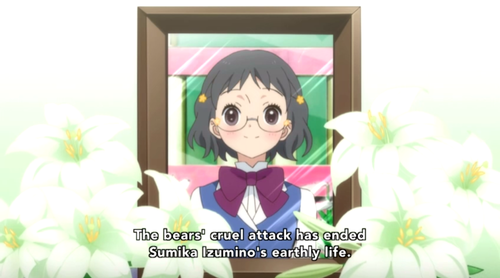
It’s Buffy Season 6 all over again!
Kureha is absent from the service, so Mitsuko gives a eulogy highlighting her gentleness, strong sense of self, and pure heart (remember that word “pure,” as we’ll come back to it a couple times today). The Lilybears watch from the back as well (shock!), but Mitsuko finishes her speech despite her Bear Shock at seeing them. Meanwhile, Kureha is converting her grief into rage, shooting bear statues at home while she denies Sumika’s death. Man, it really IS Buffy Season 6 all over again.
Back at school, the girls’ teacher Hakonaka Yuriika places Sumika’s memorial photo in a pink drawer and expressed her sympathy for Kureha.

5-Minute Mark Theory Time! Not so much a theory as just something noteworthy, but the colors on the cabinet pretty obviously form an inverted pink triangle. Inverted pink triangles are all over this series, from the triangular island-block where Kureha’s home sits to the school itself—which, it should be noted, is also surrounded by a circle of green trees. And as many of you already know, pink triangles were initially used in the Nazi concentration camps to denote homosexual prisoners. They have since been adopted as a symbol of gay pride and gay rights, and particularly the active fight for those rights. That Sumika ends up in one of many pink drawers strikes me as a quietly moving memorial to the countless people who have lost their lives due to their sexual orientation.
Back at home, the memory and/or ghost of Kureha’s mother promises her that she’ll see Sumika again. I’d like to believe that, but like Kureha I don’t. She blames herself for her inability to “protect her friend.”
Aaaand back at school again, the other girls complain about how useless the Wall of Severance seems to be, and gossip about another missing person, although no body has been found yet. The Lilybears look on, hungry as always, but Ginko is still fixated on Kureha. Lulu is impressed by Ginko’s dedication in a very bear-like fashion.
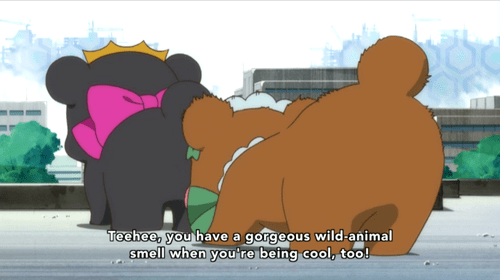
This is one of the LEAST disturbing things to happen in this episode!
She also gets a brilliant idea about how to get closer to Kureha, but we’ll have to wait for that, because we need to listen to Mitsuko consider what to do about the Lilybear transfer students, and also meet Yurikawa Konomi, Mitsuko’s friend and likely more-than-friend, given that they get all up in each other’s area codes in the hallway. Konomi’s both worried and a bit jealous about Mitsuko’s sudden interest in Kureha (“If you make friends with her, the Invisible Storm will attack you, too”). We’re also reminded that “girls who don’t follow the mood of the herd get excluded,” and it’s all played with some pretty unsettling music, so if you find yourself eeeever-so-slightly uncomfortable here, I think that’s what the show was going for.
But enough about them—time for Lulu’s Brilliant Scheme! The Lilybears show up on Kureha’s doorstep, and Lulu uses MAX ANIME EYES to work her way into Kureha’s good graces.
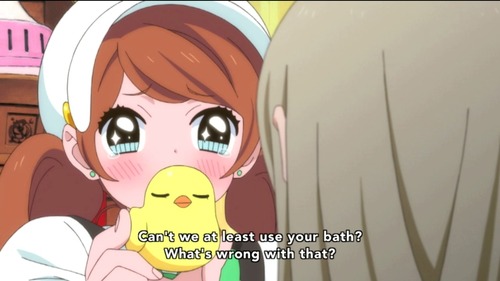
*Kawaii intensifies*
While Lulu treats herself to a bath (“I’m so clever!”) and basically has a grand old time, Ginko remains focused on Kureha. She licks her cheek in greeting (“tastes like tears”) and tries to talk to her about her feelings for Sumika, assuring her that her tears taste like “real” love. Kureha is understandably reluctant to show emotion in front of strangers (she’d kind of like them to leave as soon as possible, in fact), bu she finally snaps when Ginko says she that her love is true, too. “You don’t know anything about me!” to which Ginko responds by… uhhhh… pushing her down on the couch and grabbing her tie and pulling her towards her, and…
Okay—while odds are the Lilybears are meant to represent more than just literal bears, I think the only way we’re going to get through this show is if we assume that on some level they areliteral bears, because it’s the only way to make sense of their behavior patterns and the way the series doesn’t paint them in nearly as malicious a light as it does some of the other antagonists (more on that later).
What I mean is that the Lilybears are driven by basic desire and instinct, not by any human concept of cultural norms or morality, so we can’t really compare them to humans because they lack the self-awareness necessary to make those comparisons. It’s why they don’t seem to have anything even remotely resembling an internal monologue, and why they tend to do whatever they want, particularly when they don’t think their lives are threatened. The Lilybears are pure nature (or maybe id), which can be dangerous or benign, healthy or destructive (particularly when coupled with healthy or destructive human cultural/psychological patterns), but nature in and of itself is neither inherently good nor bad. It just exists.
This also helps explain the dualities that occur when the girls go to Kureha’s house. Lulu is painted as a basically innocuous force, carefree and a bit silly, driven by a desire for comfort and pleasure, while Ginko is aggressive and threatening, driven by hunger or lust. She’s straightforward about it, but there’s nothing even remotely human in the way she approaches it. Basically, she’s initiating a mating ritual. And while that doesn’t necessarily make it lessunsettling to watch (just ever-so-slightly more bearable), it gives us a little leeway in how we look at their interactions with Kureha. Which actually brings us to…
10-Minute Mark Theory Time! I had the slightly insane thought last week that the bears might not even be real (or at least not in the conventional sense), but I’m not sure this is as crazy as I first thought. Thing is, Ikuhara loves using cute/terrifying animals to visually represent a human character’s unspoken or internalized desires, particularly in terms of their instinct or id (the penguins in Penguindrum are usually doing the things their humans are thinking about, and I’ve recently argued that Chu-Chu functions in a similar manner for Anthy). If the Lilybears are a part of that tradition, then everything with Ginko, Lulu, and Kureha amounts to a kind of dance between Kureha and her (repressed or hidden) physical desires and needs.
After all, Kureha herself is a kind of “pure” figure—she loves Sumika, but that love never went beyond the most innocent of gestures, hand-holding and little else. This would also explain why the bears kept showing up in Episode 1 whenever the two girls were having “A Moment,” and why they keep talking about how hungry they are. This would also mean that the Lily Trials amount to a kind of internal debate for Kureha herself about the moral acceptability of her feelings, and culminate not in possible-rape but rather in a kind of liberation (libearation?): An erotic dream where she joins hands with her internal feelings/desires. …And wow. Those are not sentences I’d ever expected to write in my lifetime. DAMMIT, Ikuhara!
Wait, where were we? Oh, yeah—Ginko is being terrifying. Fortunately Mitsuko is here with her own rifle to put a stop to this nonsense. The bears flee into the sunset and Mitsuko takes off after them, leaving Kureha very confused—until a call comes in from the same Mysterious Man, telling her once again to go to the rooftop to have her love approved. Either holding out hope for Sumika’s survival or bent on revenge (or both), Kureha grabs her rifle and heads to the roof, as memories of her and Sumika planting their lily garden and watching their love slowly grow fill her head (dammit, Ikuhara!).
But it isn’t the Lilybears awaiting Kureha this time. No, it’s…
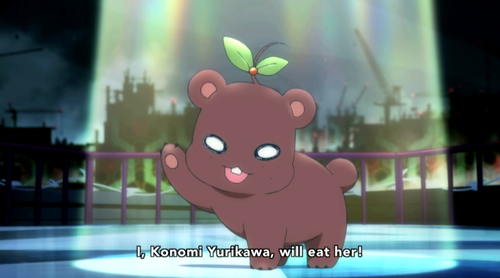
BEAR SHOCK!
Yes, turns out Konomi is a bear, too! That Wall of Severance is USELESS! Driven by her possessiveness of Mitsuko, she attacks Kureha (“Nasty girl!”). For some reason Kureha’s shots keep missing, and she’s knocked back into the Severance Court once again.
15-Minute Mark Theory Time! Because this remark somehow got left on the cutting-room floor last week, let it be known that the Severance Court is composed entirely of men, and they are the only men in the series, and this is probably really important. I was so overwhelmed by everything else going on that my initial reading was a vague “something something patriarchy,” but sharp commenters from last week’s post offered some expansions and alternate interpretations, such as that they may represent rape culture or even be a self-aware nod from the creative team (who are mostly men) about how they don’t quite belong to this world yet are dictating its story anyway.
My personal favorite, though, is that the court represents a trinity of ideal “types”—sexy, cool, and beauty—for (male) romantic leads, particularly in stories targeted towards young women (which, I’d like to add, would include both hetero relationships as well as yaoi or boys’ love stories). I don’t think we’ll know for sure until we see how (or if) the court evolves, but it’s good food for thought at this point.
Strangely (and probably importantly), the Lilybears are once again on trial (NOT Konomi), this time for gluttony, but the judge is cool with it, and everything pretty much goes the way it did last time, right down to the animation. Ikuhara’s long-running affair with motifs and repetition is on display here, and while I enjoyed it in Utena and Penguindrum I found it pretty redundant and tiring this time around. Here’s hoping the pattern doesn’t repeat itself again next week. (Although I’m sure it pleases the studio that he’s saving them so much money, recycling animation like that.)
After the ritual sex dream (growl growl!), Kureha returns to the rooftop just in time to see Mitsuko shoot Konomi through the head, killing her.
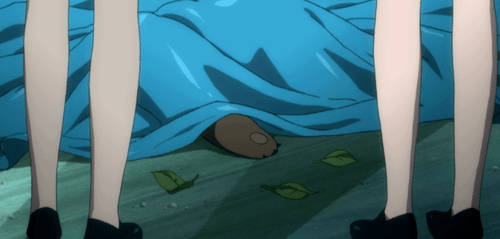
Hiiii Konomi! Byyyyye Konomi!
Wait a second, here…
20-Minute Mark Theory Time! My brain has officially overloaded with a bunch of thoughts about bears, deforestation, severance/extinction, Our Lady of Sighs, and how that all ties in with the cultural repression/exclusion of both homosexuality and female sexuality in general (and how this kind of “starvation” can be incredibly damaging to individuals, leading to negative internalized emotions such as aggression and/or self-loathing). But honestly all I can think right now is—if the bears are connected to specific humans, then did Mitsuko just kill her own bear? And is that why she’s suddenly the scariest person in this show?
Kureha notes that there are at least two bears at the school, but Mitsuko’s not worried right now. She’s more interested in comforting Kureha, assuring her that Sumika’s death isn’t her fault (“she was just unlucky”) and telling her it’s okay to cry. Also of note is that everyone keeps saying that Sumika was Kureha’s “friend,” as if they’re all afraid to use the word “girlfriend” or “partner.”
And I wish we could’ve just ended there, but no—we cut to the nurse’s office again, where Kureha is sleeping off her trauma and Mitsuko is watching over her. Very, VERY closely.
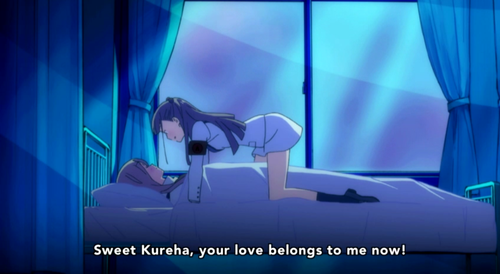
Can we have the Lilybears back, please?
The lighting and Mitsuko’s purr combines with a choral number for a truly disturbing scene, but we’re fortunate enough that Mitsuko leaves after “just” a lick to the cheek. Son of a…is she a bear, too?!
Oh, and speaking of bears:
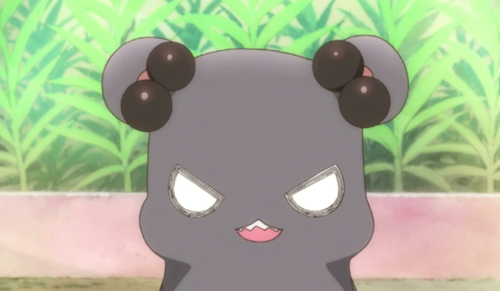
A New Challenger Appears!
A few important bits come out of this bear’s monologue: “Invisible girls only ever taste invisible,” and only girls who “won’t back down on love” truly taste delicious. Which is apparently why Sumika was the best meal this bear has ever had, and why she wants more of that flavor. Which brings up all KINDS of questions, such as: Does that mean the Lilybears DIDN’T eat Sumika? Does that mean this even creepier new bear did? But then why did Mitsuko find the Lilybears at the crime scene? Just how many bears ARE there in this school?! And why is Lulu the only one who doesn’t make me want to take a long shower?
And perhaps most impotantly: Is it too late in the semester for Kureha to transfer? Yes? No?
Afterthoughts
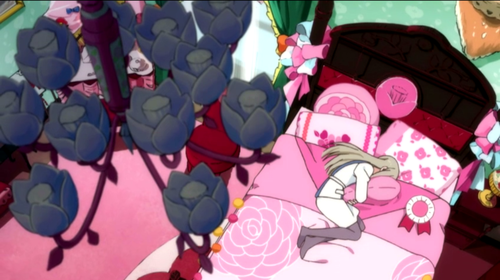
Somebody give this poor girl a hug already (NO, NOT YOU, MITSUKO).
Geez, Yurikuma is really starting to look like a horror story in every sense of the word. In fact in some ways it almost feels like the nightmare version of most of your typical anime “romance” genres, taking many of the classic tropes—a group of people (or “harem”) who have the hots for the MC, the dominant/submissive (seme/uke) relationships so common (and so very problematic) in yaoi or “boys’ love” (BL) series, and even the “Class S” relationships between girls that dominate a lot of fiction idealizing young girls—and stripping them of their romantic trappings or safety nets. “Actually, kids, that harem throwing themselves at the reluctant or unwilling hero/ine is terrifying.” “No, an obsessive aggressor pinning someone down is not romantic.” And as for those “Class S” relationships…
Okay, a quick word on those. Basically “Class S” refers to a close emotional relationship—sometimes even defined as a crush—between two girls, usually of middle or high school age. There are a few different ways this can play out, although the most common (near as I can tell), are as follows: The series is meant to (a) idealize how pure and innocent young girls are by making their friendships deeply emotional but totally sexless, (b) allow readers to “ship” a same-sex romance without the author actually having to commit to writing a real homosexual relationship (and all the backlash that might entail, depending on the target audience), or (c) is meant to titillate with implication and entendre while still insisting that the girls are interested in men, therefore making the relationship “safe” (and the girls still available for the targeted male audience). “B” has its own set of problems, to be sure, but “A” and “C” are the really pernicious ones here, promoting all kinds of harmful stereotypes about girls and how they relate both to their own sexuality and to one another.
And I bring all this up because it strikes me that Yurikuma is doing something with this genre, although I’m not quite sure what yet. I think it will depend on how we’re expected to interpret the bears, particularly the Lilybears. If my reading of them as Kureha’s own id proves true, then the series could very well be a harsh condemnation of the Class S genre, which tends to repress or hide natural desires—and not just homosexuality, but all female sexuality. Which, you know. Would be some pretty fascinating themes to see played out.
Of course, all that having been said, I have two huge concerns right now. The first is that I’m reading this all backwards: Instead of being a setup for a horror story that shines a light on harmful gender stereotypes, the dangers of repression and/or exclusion, and the homophobia present in society (both in culture and fiction), this is really just another of those hugely problematic “romances”—dressed up in cool cinematography and art design and historical/literary references, sure, but ultimately full of sound and fury, signifying fanservice. Now, the fact that the story is heavily influenced by an actual horror movie helps to ease these fears somewhat, but I couldn’t quite shake the sense of dread I felt while watching this episode, particularly when the Lilybears were at Kureha’s home.
My second concern is that, even if Yurikuma really does turn out to be all those intellectually engaging things I mentioned above, it will be so dark and disturbing that I won’t be able to stick around to see it happen. While I’m having a lot of fun researching the show’s influences and parsing through its imagery, I gotta admit that I didn’t much enjoy this episode—and in fact if you pressed me for a totally subjective opinion, I’d probably admit to disliking it. Which isn’t the best place to be when you’re spending multiple hours of your limited free time putting recaps together.
All of which is to say that I promised to give it the Three-Episode Rule and I’m holding to that, so you can count on a recap and more (over)analysis next week. But where we go from there will depend entirely on how that third episode plays out. Ikuhara is usually very good at balancing lightness and fun with some serious, complex, and often unsettling material (as both Utena and Penguindrum proved), which is part of what makes his characters and themes resonate so strongly. I hope he can find a way to bring a little of that balance to next week’s episode, otherwise I’m not sure I’ll be able to handle it (bear it?) for much longer.
Dee (@JoseiNextDoor) is a writer, a translator, a book worm, and a basketball fan. She has bachelor’s degrees in English and East Asian studies and a master’s degree in Creative Writing. To pay the bills, she works as a technical writer. To not pay the bills, she writes young adult novels, watches far too much anime, and cheers very loudly for the Kansas Jayhawks. You can find her at The Josei Next Door, a friendly neighborhood anime blog for long-time fans and newbies alike.
Are you following The Mary Sue on Twitter, Facebook, Tumblr, Pinterest, & Google +?










Published: Jan 15, 2015 08:00 pm